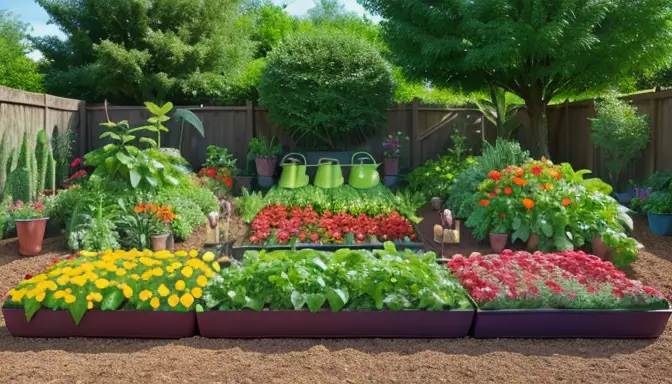Are you ready to unravel the mysteries behind 13-13-13 fertilizer? This powerful blend holds the key to unlocking explosive growth in your plants. Imagine a secret formula that provides the perfect balance of essential nutrients, like a well-guarded treasure waiting to be discovered. Let’s dive into the world of 13-13-13 fertilizer and decode its hidden potential.
- Unlock the secrets of balanced nutrition with 13-13-13 fertilizer.
- Discover the magic numbers that can transform your gardening game.
- Experience the thrill of explosive plant growth like never before.
What is 13-13-13 Fertilizer?
13-13-13 fertilizer is a balanced fertilizer that contains equal parts of nitrogen, phosphorus, and potassium.
The numbers in the 13-13-13 ratio represent the percentage of each nutrient in the fertilizer, with nitrogen (N), phosphorus (P), and potassium (K) being the primary components.This type of fertilizer is commonly used in gardening and agriculture to provide essential nutrients to plants for healthy growth and development..
When applied to plants, 13-13-13 fertilizer helps promote strong root development, vibrant blooms, and overall plant vitality. It is suitable for a wide range of plant types, making it a versatile choice for gardeners looking to enhance the health and appearance of their plants.
Using 13-13-13 fertilizer can improve soil fertility and address nutrient deficiencies, ensuring that plants have access to the essential elements needed for robust growth. This balanced formula provides a comprehensive solution for maintaining plant health and supporting optimal performance.

Benefits of Using 13-13-13 Fertilizer
When it comes to the benefits of using 13-13-13 fertilizer in your gardening endeavors, the advantages are plentiful and can lead to explosive growth and vibrant plant health. Let’s dive into the benefits:
- Even Nutrient Distribution: The balanced composition of nitrogen, phosphorus, and potassium in 13-13-13 fertilizer ensures that your plants receive a consistent supply of essential nutrients for overall growth.
- Enhanced Root Development: The nutrient-rich formula of 13-13-13 fertilizer promotes strong root systems, enabling plants to efficiently absorb water and nutrients from the soil.
- Improved Flowering and Fruiting: By providing the necessary nutrients in the right proportions, 13-13-13 fertilizer can stimulate abundant flowering and fruit production, resulting in a bountiful harvest.
- Resistance to Stress: Plants treated with 13-13-13 fertilizer are better equipped to withstand environmental stressors such as drought, pests, and diseases, leading to healthier and more resilient foliage.
- Convenient Application: The ease of application and versatility of 13-13-13 fertilizer make it a convenient choice for both novice and experienced gardeners looking to boost plant growth and vitality.
How to Properly Apply 13-13-13 Fertilizer
When it comes to applying 13-13-13 fertilizer to your plants, it’s essential to follow the correct methods to ensure optimal growth and health. Here are some steps to properly apply 13-13-13 fertilizer:
- Begin by carefully reading the instructions on the fertilizer packaging to determine the recommended application rate.
- Choose a dry day to apply the fertilizer when there is no rain forecasted to prevent it from being washed away.
- Before applying the fertilizer, water your plants lightly to help the soil absorb the nutrients more efficiently.
- Measure the appropriate amount of fertilizer according to the size of your garden or the specific plant’s needs.
- Evenly spread the fertilizer around the base of the plants, keeping it away from the stems to avoid burning them.
- After application, water the plants thoroughly to help the fertilizer penetrate the soil and reach the roots.
Potential Risks and Concerns
When it comes to using 13-13-13 fertilizer in your gardening practices, there are certain potential risks and concerns that you should be aware of to ensure the health and well-being of your plants. Let’s delve into some of the key points to consider:
- Overfertilization: One of the primary risks associated with 13-13-13 fertilizer is the potential for overfertilizing your plants. Applying excessive amounts can lead to nutrient imbalances, burning of roots, and overall stress on the plants.
- Environmental Impact: Improper use of fertilizers like 13-13-13 can contribute to water pollution if runoff carries excess nutrients into water bodies, causing algae blooms and disrupting aquatic ecosystems.
- Plant Damage: Using 13-13-13 fertilizer incorrectly, such as applying it during sensitive growth stages or in high concentrations, can result in stunted growth, leaf burn, or even plant death.
- Residue Buildup: Continuous use of 13-13-13 fertilizer without proper soil testing and monitoring can lead to the accumulation of salts and chemicals in the soil, affecting long-term soil health.
It is
essential to follow recommended application rates, timing, and guidelines to mitigate these risks and ensure that the benefits of using 13-13-13 fertilizer outweigh any potential concerns.Monitoring your plants’ response to the fertilizer and adjusting your application practices accordingly can help you maintain a healthy and thriving garden..
Alternatives to 13-13-13 Fertilizer
When considering alternatives to 13-13-13 fertilizer, it’s essential to explore various options that can cater to different plant needs and soil conditions. Here are some alternatives to consider:
- Organic Fertilizers: Organic fertilizers like compost, manure, or fish emulsion provide natural nutrients to plants without the risk of chemical buildup in the soil.
- Slow-Release Fertilizers: These fertilizers release nutrients gradually over time, ensuring a steady supply of essential elements for plant growth.
- Specialized Fertilizers: Depending on the specific needs of your plants, specialized fertilizers such as high-nitrogen or high-potassium blends can address targeted deficiencies.
- Microbial Inoculants: These products contain beneficial microorganisms that enhance nutrient uptake and improve soil health, promoting overall plant vitality.
By co
nsidering these alternatives, you can tailor your fertilization approach to meet the unique requirements of your plants and promote healthy growth without relying solely on 13-13-13 fertilizer.
Understanding N-P-K Ratios
When it comes to fertilizers, understanding the N-P-K ratios is crucial for ensuring the health and vitality of your plants. The N-P-K ratio stands for the percentage of nitrogen (N), phosphorus (P), and potassium (K) present in the fertilizer. Each of these nutrients plays a vital role in supporting different aspects of plant growth and development.
Nitrogen (N
) is essential for leafy green growth and overall plant vigor. Phosphorus (P) is crucial for root development, flowering, and fruiting. Potassium (K) helps with disease resistance, water uptake, and overall plant strength. The balance of these nutrients in the fertilizer directly impacts the plant’s ability to absorb them and thrive.When selecting a fertilizer with an N-P-K ratio like 13-13-13, it means that the fertilizer contains an equal proportion of nitrogen, phosphorus, and potassium. This balanced ratio is suitable for general plant maintenance and can be a good all-purpose choice for many plants.
However, different plants have varying nutrient requirements at different growth stages. Some may need more nitrogen for lush foliage, while others may require extra phosphorus for blooming. Understanding the N-P-K ratios allows you to tailor your fertilizer choice to meet the specific needs of your plants for optimal growth and health.


